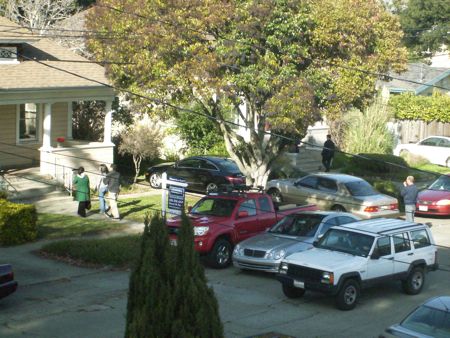“Favorite crossing guard” read the sheet of poster paper someone had taped to the green-painted steel utility box that stands next to the traffic lights at Nelson and Charleston Roads. Another sign taped to the utility box read “Charles, you’re the best.” Whoever had taped up the signs left pens and markers so that passers-by could leave their own message to Charles, who is retiring, and whose last day at the crossing was Thursday.
Earlier this week, I had been talking with Charles about his upcoming move to Georgia, where retirement money goes a lot farther than here in the Bay area. But we didn’t stay long on that topic. Years ago, Charles had been a case manager in Cleveland working with emotionally disturbed children, before he moved to the Bay Area and became a custodian. (I never asked him about the career change, but moving from a burnout job with low pay, to a stable union job, sounds pretty attractive to me.) As is inevitable when two people get together who work with kids, we started talking about kids we had known and worked with. I’ve seen some troubling things in my career as a children and youth minister, but of course Charles had seen much worse.
This was one of the few uninterrupted conversations we have ever had, in the two years Charles has worked at this crossing. I probably saw him once or twice a week on my way to get lunch at the supermarket across the street, but mostly he spent his time talking to the kids from the nearby elementary school and middle school who went past. He seemed to know them all by name, and if a child came up while he was talking to me, he’d immediately greet that child, and turn his attention to them. It’s an unusual adult who can do that without being creepy; I like adults who treat adults and children with equal respect, and I like the more unusual adult who will end a conversation with another adult in order to have a conversation with a child. But on this day, I happened to come along when no kids were coming by, so we talked about kids: happy kids, troubled kids, kids who needed to talk with an adult who has excellent listening skills. Both of us have been trained to keep confidentiality, so there were no names or identifying characteristics; you can still have a good conversation of this sort without breaking confidentiality.
So on Thursday, I walked up to those two posters someone had left, and I read some of the things the kids wrote to Charles: they mentioned little in-jokes he had had with them, they wrote how much they’d miss him. I thought about signing one of the posters, but it seemed more appropriate to let the kids have their say, on their own. I wished Charles luck in my head, and walked on by.
News story about Charles here. As it happens, it was a member of our church who created the retirement posters.



